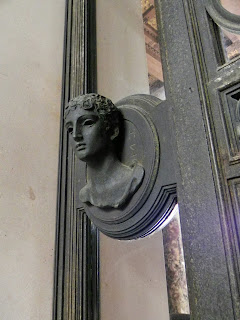We saw two bathrooms in the villa. One was just off the entry. It included a huge shower, as well as a soaking tub, reminiscent of the ones in Japan. The water was moved by jets, like a hot tub, though. Again, there is the beautiful inlay work as well as the exquisite marble. This room has electric lighting which has nothing to do with the Greeks and everything to do with showing off the room. There is also large shower, with the toilet in a separate closet.
 |
| An extremely large and deep soaking tub. |
 |
| The room is round, so the sink is fitted into an alcove. |
 |
| View over the tub toward the sink. The lighting was very complimentary. |
The second bath was used by the owners. It was more functional, with a regular, but oversized bathtub, along with the huge walk in shower.
 |
| The other bathroom sink. |
 |
| Stepping down into the shower. |
 |
| A nice tub to lounge in at the end of the day. |
Kerylos was given to the Institute de France when the owner died in 1928. Except for when the German's occupied it during WWII, his children and grandchildren continued to live there until 1967, when it was classified as a Monument Historique.




















































